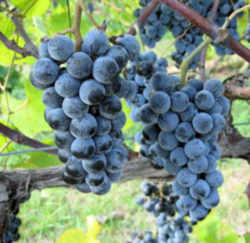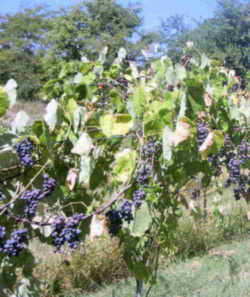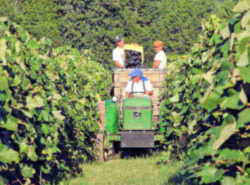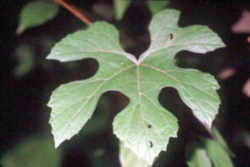
Arkansas Symbols
Arkansas State Grape
Cynthiana grape

(Vitis aestivalis)
Adopted on 2009.
The north central part of Arkansas has a rich heritage of vineyards and wineries. Arkansas is also the oldest grape juice and wine producing state in the southern United States. Approximately 150 commercial wineries have operated in Arkansas since 1870; as of 2009, seven wineries continue this tradition. Acknowledging this unique part of Arkansas state's history, the General Assembly of 2009 adopted the Cynthiana as Arkansas's official state grape.
STATE GRAPE DESIGNATION Act 547 (HB2193) - The act designates the Cynthiana grape as the official grape of the State of Arkansas.
Arkansas State Grape: Cynthiana grape

Arkansas does have an official state grape. It's the Cynthiana, the oldest North American grape in cultivation today. First identified in 1770, it's often referred to as the "Cabernet of the Ozarks."Similar to the Norton grape, the Cynthiana is winter-hardy and highly disease-resistant. It's used in deep red wines and is credited with being a great artery de-cloggier. Several of the state's wineries utilize Cynthiana grapes in their wines, particularly Post Familie, Mount Bethel, Chateau Aux Arc and Keel's Creek.
History of Grape and Wine Industry in Arkansas
Arkansas is the oldest and largest grape juice and wine producing state in the southern United States. Grapes were first grown commercially in Arkansas by a colony of German-Swiss immigrants who settled at Altus (Franklin County) in the 1870's. These early settlers soon recognized that this region in the foothills of the Ozark Mountains had the potential for wine grape production. The Boston Mountains to the north provided a barrier to the winter cold, and the elevation of the small, flat-top mountains provided the necessary protection from spring frost. The soil of the region was well-suited to grape production.
Early winemakers found a ready market for their product among the immigrant railroad workers and coal miners who were accustomed to enjoying wine with their meals. Some of the early winemakers in the area were Wiederkehr, Post and Sax. Several wineries still operate in the Altus area and are run by the fourth and fifth generation descendants of these original wine families.
Professor Joseph Bachman was a Swiss immigrant and grape breeder in the Altus, Arkansas area in the late 1880s. The cultivars he developed drew nationwide attention.
During the Prohibition era, many of the wine grapevines were grafted over to table grape cultivars. Private grape breeders such as Joseph Bachman developed Sunrise, Stark's Star and Banner cultivars. Herman Wiederkehr discovered a bud mutation of Campbell's Early during this period and sold the propagation rights to Stark Brothers Nurseries. This became Stark's patent No. 1.
With the repeal of Prohibition, the wineries in the Altus area expanded significantly. Most of the plantings now are devoted to the best of the French-American Hybrids and the hardy Vitis vinifera. Al Wiederkehr of Wiederkehr Wine Cellars is given credit for pioneering the first commercial vinifera plantings in Arkansas.

There are now four major wineries in Arkansas with a storage capacity of approximately 1,230,000 gallons. Two of these wineries, Wiederkehr Wine Cellars Inc. and Post Familie Vineyard and Winery in the Altus area are in the top 100 wineries in the United States in terms of wine gallons produced annually.
Another early grape production center was established in Northwest Arkansas (Washington County) by Italian immigrants. The first 100 families of Italian immigrants settled in Sunnyside, AR, in the southeastern corner of the state, on a large plantation owned by Austin Corbin. Three years after their arrival, a double tragedy struck. Their benefactor, Corbin, died, and a malaria epidemic spread throughout the new colony. Over 100 people died in one year. These Italians from the mountainous climate of the Alps and Appenines could not acclimate to the conditions of the Eastern Arkansas swamps.
A Catholic priest, Father Bandini of New York, heard of the plight of the Italian immigrants and came to their rescue. He gathered the 20 remaining families and in the late 1800's took them to an area in northwest Arkansas, where he purchased 700 acres of land and founded the town of Tontitown. These people soon found that 'Concord' juice grapes as well as hardy wine grapes thrived in this area and provided excellent quality juice.
Welch Foods learned of this group of grape growers and in 1922 built a Concord juice plant in Springdale. By 1992, this plant had a juice storage capacity of 1.9 million gallons. It was sold to Ozark Valley Products then bought by Pappas Foods, International, which continues to process grape juice as well as other fruit juice products.
Early wineries were established in the Tontitown area, but none of these are operating today. However, wine grapes are still produced in Northwest Arkansas and shipped to the Altus wineries.
Characteristics of the Cynthiana grape
Leaf:

Alternate, simple, cordate, 4 to 6 inches long, toothed and often lobed, green above, red woolly hairs beneath.
Flower:
Green, generally not showy, borne on panicles, appearing in late spring.
Fruit:
An edible berry, 1/4 to 1/2 inch in diameter, occurring in clusters, usually dark blue or purple at maturity, often with a glaucous bloom, maturing
in early fall.
Twig:
Stems are mostly rounded, with rounded buds that have two bud scales; terminal bud is false; branching tendrils grow opposite the leaves, do not have
adhesive tips and are generally absent every third node, woody partitions across pith at nodes.
Bark:
Reddish brown, long splits develop with coarse peeling, narrow strips.
Form:
A vine that climbs to 70 feet with its curly tendrils; it can smother tree canopies.
The Arkansas Code
The law designating the Cynthiana grape as the official Arkansas state fruit is found in the 2014 Arkansas Code Title 1 - General Provisions Chapter 4 - State Symbols, Motto, Etc. Section 1-4-129
Title 1. General Provisions.
Chapter 4. State Symbols, Motto, Etc.
SECTION
§ 1-4-129 - State grape.
(a) The Cynthiana grape, or Vitis Aestivalis, is designated the official grape of the State of Arkansas.
(b) (1) This section does not require a state agency or office to republish a publication or brochure in order to list or display the state grape.
(2) A state agency or office may include the information concerning the state grape in future publications or brochures or in
a scheduled update to a publication or brochure.
(c) This section does not grant a protected status to the Cynthiana grape.
Taxonomic Hierarchy: Cynthiana Grape
Kingdom: Plantae - Plants
Subkingdom: Tracheobionta - Vascular plants
Superdivision: Spermatophyta - Seed plants
Division: Magnoliophyta - Flowering plants
Class: Magnoliopsida - Dicotyledons
Subclass: Rosidae
Order: Rhamnales
Family: Vitaceae - Grape family
Genus: Vitis L. - grape
Species; Vitis aestivalis Michx. - summer grape

List Official US State Foods






